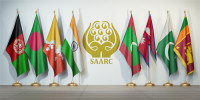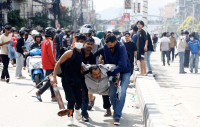Opinion
Political borders of museums
Narayanhiti museum has become a metaphor of confusions surrounding the change-savvy Nepali politics today
When a senior scholar named Bryony Whitmarsh raised very searching questions about museums in Nepal, especially the Narayanhiti museum, at SOAS, University of London in early November last year, I was once again drawn to the subject. When I had met her in Kathmandu some years back, the subject of our discussion had been Narayanhiti, though we had also covered many other subjects related to museums in Nepal. Like the previous time, I sat there feeling a little nervous about my ability to discuss the subject, as it had become more complex over the years. That morning, in an eatery at SOAS, where Prof Michael Hutt had taken me to meet Bryony, I was getting nervous for some other reason also. That very afternoon, I was going to give my annual lecture for the Britain Nepal Academic Council on the writings and philosophy of the writer, statesman and first democratically elected prime minister of Nepal (1958-1960) Bishweshwar Prasad Koirala, alias BP. Bryony’s topic of the Narayanhiti museum reminded me of the erstwhile Narayanhiti royal palace that BP remembers in his memoirs for some other reason. He always regretted his decision to keep a contingency of Nepal Army inside the palace to guard the king who later used it to stage a coup to remove BP’s democratically elected government and introduce the autocratic Panchayat system that ruled for 30 years. To speak of the Narayanhiti power centre as a museum was therefore a jolt for me, even though I had published several articles about it and presented a paper at an international conference.
Two perspectives
Facing the queries of a brilliant foreign scholar, my first problem was to work out a certain balance within myself—the balance between the stark realities represented by that architecturally nondescript space and its historicity. The palace now haunts me like a spectre as discussed by the French philosopher Jacques Derrida. I have written about its spectrality, describing this palace of the kings of the House of Gorkha for over a century and a half, a metaphor of Nepali history. Today when the country is debating about the structure of federalism, when cartographic imagination has replaced the monolithic geographical descriptions of the natural resources, this palace theoretically turned into a museum, is raising questions about its validity and significance. Researchers, especially from abroad, have been looking at this complex with an interest in its historicity, which has two perspectives. One is visible, and is full of overstated and clear narratives. The other is mysterious and understated. I was first drawn to this architectonic site and a wide space guarded for nearly two centuries, in August 2008, three months after the last king of the House of Gorkha, Gyanendra Shah, left the palace. The context was a seminar organised by the International Coalition of Sites of Conscience in September 2008 in Phnom Penh, for which I was preparing a paper.
Drawn by the visible, I was groping, as it were, for the invisible and the mysterious in my first visit to the Narayanhiti Palace.
When you visit a site so important as the royal palace of the erstwhile regime, your only basis for knowing about its historicity will be its items, props, archival collections and anything that carries the memory of the house. The inner narratives, the shenanigans, and the borders remain the eternal subject for historians and researchers to explore. As the Royal Massacre of 2001 remains an unexplored and unexplained event, the politicians and the successive government leaders found it more convenient to turn the house into a museum. Challenged by history, they left it alone with all the spectres of power of the bygone days to remain vying for visibility there.
A metaphor
A gallery of sad women’s portraits on the ground floor, and upstairs, icons, some jewels of the crown, huge photographs of visitors, carpets made in different districts of Nepal put in a very monotonous, cliché style, high-security royal bedrooms with windows overlooking the wide street as far as the clock tower of the first college Trichandra—nothing struck me as a museum. To add to that, someone said, up at the palace tower there was a window, an aperture perhaps, from where the king used to measure the size of the demonstrations. Bryony wanted to make sure which demonstration, one in 1979 or the bigger one in 1990, Birendra saw from there. Perhaps I chose the wrong date for her. Though no clear picture of that space as a museum would come to me as it might to a foreign scholar, my perception of that space as a metaphor of border-crossing in Nepali political and cultural history is not diminished.
In Cambodia where I presented Narayanhiti as a museum in my paper, I felt I was saying very little. I felt so especially when the survivor of the Khmer Rouge torture camp, artist Vann Nath, took me to see Cambodia’s bizarre national memorial, where he was put in chains to the point of death. When I saw Tuol Sleng, the erstwhile school where the torture had taken place, turned into a Genocide Museum for the promotion of ‘dark tourism’ as it were, I deeply felt that turning power centres into museums is a very complex border-crossing. Later when I wrote an obituary of Vann Nath in The Kathmandu Post in September 2011, I realised that my sense of a museum that is related to power and force had already taken a new meaning. Though I have become a stronger believer in the power of museums, I feel what they house, who wants to house them and who wants to see them should be clear. The Narayanhiti museum, by failing to answer these questions, has become a metaphor of the confusions that surround the change-savvy Nepali politics today.




 9.12°C Kathmandu
9.12°C Kathmandu









